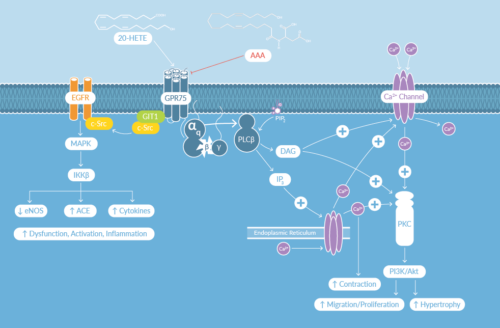G protein-coupled receptor 75 (GPR75) has been identified as a 20-HETE (20-Hydroxyeicosatetraenoic acid) receptor. It signals through Gq/phospholipase C (PLC)/protein kinase C (PKC) and c-Src/EGFR pathways (Figure 1). Previously GPR75 was deorphanized as an inflammatory chemokine receptor when CCL5/RANTES was identified as its ligand. Through GPR75, RANTES was shown to activate MAPK signaling to protect hippocampal HT22 cells from amyloid-β-induced cell death and to stimulate insulin secretion in pancreatic islet cells.1,2 Now it has been established that 20-HETE, a member of the cytochrome (CYP) P450-derived eicosanoids, acts through the same receptor to elicit vascular effects.3
Deorphanized GPR75 Adopted by 20-HETE
20-HETE (20-Hydroxyeicosatetraenoic acid) is a major metabolite of arachidonic acid produced by CYP4A and CYP4F that acts as a potent vasoconstrictor. It also plays roles in sodium transport, endothelial dysfunction, oxidative stress, cell proliferation, vascular hypertrophy, inflammation, and angiogenesis. Increased levels of 20-HETE are associated with cerebral, renal, and cardiovascular diseases, including hypertension, stroke, coronary artery disease, myocardial infarction, acute kidney failure, chronic kidney disease, polycystic kidney disease, as well as conditions that are associated with hypertrophy and hyperplasia such as tumor growth and metastasis, end-organ damage, and fibrosis.
Because 20-HETE (20-Hydroxyeicosatetraenoic acid) is rapidly esterified into membrane phospholipids, identifying the receptor it activated remained elusive until Garcia et al. designed a shrewd, multi-step strategy to cross-link a fluorescently tagged, photoactive 20-HETE antagonist to the cell surface, isolate the labeled proteins, and use proteomics as well as bioinformatics to identify its binding partners.4 The Schwartzman lab at New York Medical College has demonstrated that 20-HETE binding to GPR75 promotes dissociation of the Gq subunit and the association of GPCR-kinase interacting protein-1 (GIT1) to GPR75, which facilitates the release of c-Src from the GPR75 receptor freeing it to phosphorylate EGFR, activating the MAPK/IKKβ/NF-κB pathway (Figure 1). This signaling pathway is related to uncoupling of eNOS, endothelial dysfunction, and increased expression of angiotensin-converting enzyme (ACE). 20-HETE activation of NF-κB signaling also induces the expression of cellular adhesion molecules and cytokines, thereby promoting inflammation. They have also shown in endothelial and smooth muscle cells that 20-HETE activates the classical Gq-coupled PLC/IP3 signaling pathway that results in release of calcium from intracellular stores, which leads to a vasoconstrictor response (Figure 1).
GPR75 is expressed in the brain, heart, and kidney, each of which participate in blood pressure control and can produce 20-HETE. Moreover, 20-HETE is a significant contributing factor to the pathophysiology of hypertension, stroke, and cardiovascular diseases.5,6 It also regulates the ischemic neovascularization process through combined actions on endothelial progenitor cells and pre-existing endothelial cells.7 Studies also suggest a role for 20-HETE in obesity, insulin resistance, and metabolic syndrome wherein elevated levels interfere with insulin signaling and glucose metabolism.8 20-HETE activation of GPR75 is also linked to PKC activation and signaling in prostate cancer cells.9
The identification of a GPCR signaling pathway for 20-HETE has launched a new avenue for the discovery of molecules that could interfere with the hypertensive, inflammatory, or cancer-promoting actions of 20-HETE. For example, the GPR75 antagonist AAA reduces 20-HETE-induced activation of EGFR, NF-κB, and Akt in prostate cancer cells.9 It can also reduce systolic blood pressure, albuminuria, renal angiotensin II levels, and cardiac hypertrophy in a Cyp1a1-Ren-2 transgenic rat model of malignant hypertension.10 In time, more antagonists are likely to be uncovered.
Cayman offers 20-HETE, analytical standards, the AAA antagonist, as well as 20-HETE synthase inhibitors to support the exploration of the role of 20-HETE in a variety of diseases and pathologies.
Learn More About the Major Eicosanoid GPCR Signaling Pathways
- Updated wall Poster: Eicosanoid GPCRs
- Illustrates the intracellular signaling pathways activated by each major lipid mediator following receptor engagement.
- Recently updated to include the deorphanized GPR75 receptor, which 20-HETE binds.
- Watch this short introductory video to take a closer look at what’s new in this poster.
- Contact us to receive the wall poster.
- Web Page: Tools to Study Eicosanoid GPCR Signaling
- This web page features Cayman’s extensive library of agonists, antagonists, assays, and antibodies to study the function of eicosanoid receptors. Explore research products associated with each distinct signaling pathway as a companion to the Eicosanoid GPCR poster.

